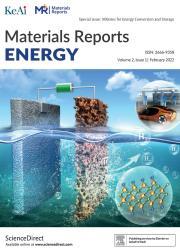Identifying the tri-roles of anion vacancy on improving K-ion storage
IF 13.8
引用次数: 0
Abstract
Anion vacancy engineering (AVE) is an emerging strategy to improve K-ion storage of conversion-type anode materials, despite its intensive application in Li/Na-ion batteries. The existing mechanisms of AVE's effects mainly focus on charge transfer but fail to clarify other critical issues. Here, we propose a new insight into AVE's effect on K-ion storage by introducing Te vacancies into a representative conversion-type NiTe. In addition to existing mechanisms, we demonstrate Te vacancies play three other unprecedented roles. (1) Te vacancies minimize the intrinsic volume strain from 15% to 6%, significantly suppressing anode pulverization and element dissolution. (2) Te vacancies induce the in-situ formation of a thin yet robust KF-based inorganic-rich solid electrolyte interphase, further accommodating volume strain and element dissolution. (3) Te vacancies reduce Ni-Te bond lengths and promote K-ion diffusion by modulating local atomic structure. Therefore, NiTe1−x delivers an outstanding cycling performance (229.5 mAh g−1 at 3.0 A g−1 for 1350 cycles) and rate capability (171.7 mAh g−1 at 5.0 A g−1). Furthermore, NiTe1−x-based full cells showcase a remarkable energy density of 200.4 Wh kg−1. This work comprehensively elucidates the AVE's effects on alkali-ion storage, promoting the development of advanced conversion-type anode materials for practical applications.

确定阴离子空位对改善k离子储存的三重作用
阴离子空位工程(AVE)是一种新兴的改善转换型负极材料k离子存储的策略,尽管它在Li/ na离子电池中得到了广泛的应用。现有的AVE效应机制主要集中在电荷转移上,而没有阐明其他关键问题。本文通过在具有代表性的转换型NiTe中引入Te空位,对AVE对k离子存储的影响提出了新的见解。除了现有机制外,我们还证明了空缺还发挥了另外三个前所未有的作用。(1)空穴使本质体积应变减小15% ~ 6%,显著抑制阳极粉化和元素溶解。(2)空位诱导原位形成薄而坚固的kf基富无机固体电解质界面,进一步适应体积应变和元素溶解。(3)空位通过调节局域原子结构,减少Ni-Te键长,促进k离子扩散。因此,NiTe1−x具有出色的循环性能(229.5 mAh g−1,3.0 A g−1,1350次循环)和速率能力(171.7 mAh g−1,5.0 A g−1)。此外,基于NiTe1−x的全电池显示出200.4 Wh kg−1的显著能量密度。这项工作全面阐明了AVE对碱离子存储的影响,促进了先进转化型阳极材料的实际应用。
本文章由计算机程序翻译,如有差异,请以英文原文为准。
求助全文
约1分钟内获得全文
求助全文
来源期刊

材料导报:能源(英文)
Renewable Energy, Sustainability and the Environment, Nanotechnology
CiteScore
13.00
自引率
0.00%
发文量
0
审稿时长
50 days
 求助内容:
求助内容: 应助结果提醒方式:
应助结果提醒方式:


